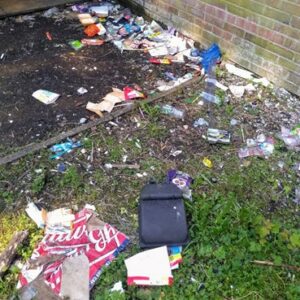Young people and Anti-Social Behaviour in a derelict nightclub
<<Back to Case Studies
A nightclub had closed down and become neglected. Because the area surrounding the building is secluded with easy access and no lighting, there was a rise in reports of anti-social behaviour (ASB) at the location.

The ASB included arson, underage drinking, drug dealing, large groups of young people causing intimidation, and damage caused to the nightclub and surrounding areas/ neighbouring buildings.
This resulted in raised community tensions and increased demand for the local Neighbourhood Policing Team and other partner agencies, including the Fire Service.
A plan utilising the OSARA (objective, scanning, analysis, response and assessment) problem-solving methodology was put in place by the Police and a multi-agency approach was undertaken to resolve the issues in the area.
Various agencies and departments including WCADA (Welsh Centre for Action on Dependency and Addiction), Fire and Rescue Service, Community Alcohol Partnerships, Police, Local Authority Waste Enforcement, Licencing, Trading Standards, local business owners and local council officers were made aware of the issues and worked together to prevent ASB and criminality at the location and decrease community tension and demand.
The multi-agency work undertaken to tackle the issue included:
- A weekend of action with partner agencies to engage with the young people and to deter the ASB issues.
- An Arson Education Officer attended local schools to conduct lessons with the age groups identified.

- High visibility targeted patrols were conducted at specific times identified from the reports.
- ASB and Arson posters were placed at key locations.
- The Local Authority addressed the graffiti in the area.
- Waste Enforcement addressed the amount of litter and possible vermin at the location and considered taking enforcement action.
- The local Neighbourhood Policing Team, ASB Officer, Crime Reduction Tactical Advisor and Arson Reduction Officer attended the location to speak with the owner, identify risks and provide target hardening/ crime prevention advice. The business owner took ownership in clearing the land and carried out the suggested improvements.
- Neighbourhood Officers attended local shops to re-educate staff about the sale of alcohol to underage persons and to challenge young adults who are with young people.
The owners of the building have since transformed the premises, which has now been leased to a new tenant. The building is open to all ages, seven days a week, and now provides a safe space for young people to attend and take part in an activity in a place that integrates them with the wider community.
Due to the new use and accessibility of the building, no ASB issues have been reported at the location.
The building and its grounds are also secured after hours with locked gates at all entrances, which has deterred the young people from entering and congregating in the area.












